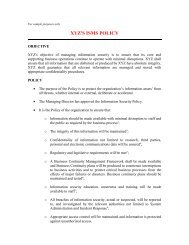Contributors - CyberSecurity Malaysia
Contributors - CyberSecurity Malaysia
Contributors - CyberSecurity Malaysia
You also want an ePaper? Increase the reach of your titles
YUMPU automatically turns print PDFs into web optimized ePapers that Google loves.
18.Guide to Motion Compensation (PhaseCorrelation and Vector Assignment)IntroductionThere are now quite a few motion-compensated productsin the market, but not all work in the same way. Thepurpose of this article is to introduce the surroundingmotion estimation by explaining clearly how it works.Different sources from video may demonstrate widelyvaryingmotion characteristics. All types of motion mayappear to perform similarly. This article will explain motioncharacteristics and performance motion compensationsystems. Furthermore, this technology will help videoforensics analysts to reduce the noise and shake level fromthe video source in a case investigation.1.0 Phase Correlation (PH.CTM)Phase Correlation is a method to check the similarity oftwo images with equal size. It can be used for templatematching, object tracking, motion estimation, etc. In thisarticle, I will explain the basics and the code to performPhase Correlation.Benefits of using Ph.CTM Phase Correlation:i. Immunity to noisy sources – Noise does notcorrelate. Able to work with archive or amateur shotvideos.ii. Immunity to luminance variations – Frequencydomain.iii. Accurate cut detection – Able to work with edited ormultiple camera sequences.iv. Significant bandwidth savings for downstreamMPEG encoding.2.0 Vector AssignmentThe phase correlation process produces candidate vectorsin each window. The vectors from all windows can becombined to obtain an overall view of the motion in the fieldbefore attempting to describe the motion of each pixelindividually. For example, Photo 1 shows the geometricprogression of window vectors, which means the zoom onthe moving object is in progress. (Refer to the red circleand the scattered movement of the white lines).Figure 1 shows what happens. If the two fields are thesame, there are no phase differences between the two,and all of the frequency components are added with a zerodegrees phase to produce a single peak in the centre of theinverse transform. However, if there was motion betweenthe two fields, such as a pan, all of the components willhave phase differences, and this results a peak is displacedfrom the centre of the inverse transform by the distancemoved. Phase correlation thus measures the movementbetween fields, rather than inferring it from luminancematches.a) b)Photo 1: Phase Correlation Motion VectorIf a zoom is in progress, the vectors in the various windowswill form a geometric progression, becoming longer inproportion to the distance from the axis of the zoom asshown in Figure 2. However, if there is a pan, as is seenin Figure 3, there will be similar vectors in all windows. Inpractice both motions may occur simultaneously.Figure 1: Demonstrate the process of phase correlation techniqueswhere diagram a) shows a single peak in the centre ofthe inverse transform whereas diagram b) shows a peakdisplacement from the centre of the inverse transform bythe distance moved










